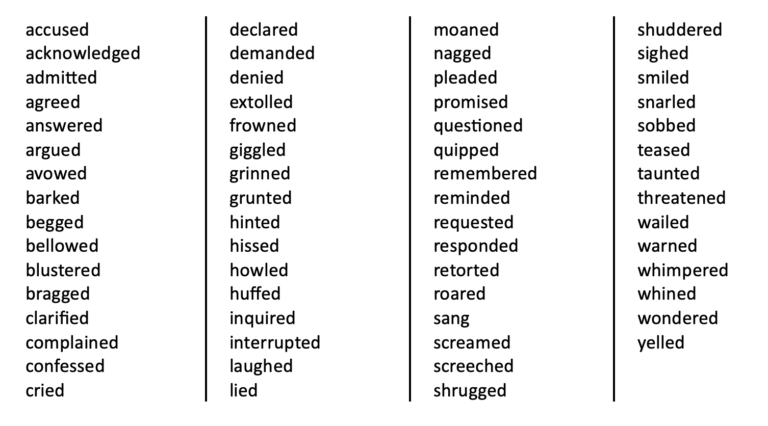The Physically Impossible
“My heart is yours,” he smiled.
“That’s wonderful,” he nodded.
“You’re crazy,” she laughed.
“I don’t know,” she shrugged.
Can you moan a sentence, grin a saying, laugh a response, or howl or giggle a phrase? No, you have to speak it, but that speech can be accompanied by a moan, smile, grin, shrug, laugh, howl, or giggle. The same applies for your characters.
Exaggerated … Redundant … Unnecessary
“Go on then,” she insisted.
“Leave me alone,” he pleaded.
“Can I go with you?” she cajoled.
“I could go on,” she admitted.
“What time is it?” he questioned [or inquired].
“I think not,” he commented.
“Give it back!” she demanded.
“Yes, it’s mine,” she acknowledged.
“I’m not understanding why you insist on being difficult,” he sermonized.
After a few pages of this to any experienced reader, it begins to come across as rather ridiculous and more than a little tiring.
If you find yourself using these as dialogue tags, rewrite to SHOW your characters in the action you want conveyed through situation context rather than TELL your reader how dialogue was delivered. These should be inferred by the dialogue itself along with action beats.
Don’t Insult Your Reader
Certain synonyms for “said” are so completely unnecessary they’re more insulting to the readers’ intelligence than anything. Words such as questioned, prodded, pleaded, insisted, agreed, or accused, for example, aren’t needed when the dialogue clearly shows what is occurring.

The Simple Reason to Keep It Simple
Readers are so accustomed to seeing “said” and “asked” that the eye quickly skims over them. Any other words can be a distraction [keyword]. Remember your goal when using dialogue tags is to avoid drawing attention to the dialogue tag itself. So, you don’t want to use any word that’s going to trip the reader up or make them work to finish your story.
Empowering Your Dialogue
The rule of thumb is that effective dialogue tags must convey information about how a line is delivered based on the mindset or action of the speaker and that the reader can’t be expected to infer simply through the dialogue itself. Utilize facial expressions and body language to convey the speaker’s tone and mood. To be acceptable, a dialogue tag that deviates from the simplistic must add some new understanding that doesn’t insult the reader’s intelligence.
“But I gave you the money,” he stammered.
“I said no,” she whispered.
“I bet you won’t,” he muttered under his breath.
She rolled her eyes. “Whatever.”
Unacceptable or Unnecessary Dialogue Tags
Use of these words as dialogue tags is a surefire sign that you’re telling and not showing. These words unnecessary if your prose is well-written before and after the dialogue.

Unacceptable or Unnecessary Dialogue Tags
Famous Authors on the Matter
- Stephen King: In his book On Writing: A Memoir of the Craft, Stephen King advises against using too many synonyms for “said” and instead recommends using dialogue tags sparingly. He suggests using action beats and character descriptions to convey tone and emotion instead.
- Elmore Leonard: Elmore Leonard, known for his crime fiction, believed that using too many synonyms for “said” was a sign of bad writing. He once famously said, “Never use a verb other than ‘said’ to carry dialogue.”
- J.K. Rowling: In her Harry Potter series, J.K. Rowling uses a variety of dialogue tags beyond “said,” such as “whispered,” “muttered,” and “shouted.” However, she also uses action beats and character descriptions to convey tone and emotion in her dialogue.
- Ernest Hemingway: Ernest Hemingway was known for his sparse, straightforward writing style, and he often used “said” as his primary dialogue tag. He believed that the words spoken by the characters were more important than how they were said, and that the reader should be able to infer tone and emotion from the context.
Conclusion and A Challenge
Challenge yourself to write in a way that makes it clear who is speaking and how. You also don’t want to go overboard with using “asked” and “said” everywhere they fit. Try to maximize using action beats and characterization, using these only when necessary. Then, exercise your skill further during the rewriting/revising phase and see how many you’re able to remove altogether without making the passage difficult for your reader to follow who’s speaking.
If you found this helpful or you disagree, comment below. What are your thoughts on “said is dead”?
